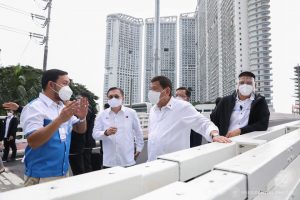When Rodrigo Duterte assumed the presidency of the Philippines in 2016 his economic vision for the country was pretty clear: to build infrastructure and boost investment. The cornerstone of this plan was the Build, Build, Build program, in which the government targeted dozens of infrastructure projects for priority development through a combination of public and private funding from both foreign and domestic sources.
As Duterte’s six-year term neared its conclusion, the government also passed several investor-friendly legislative reforms meant to accelerate foreign capital inflows. These included relaxed restrictions on foreign ownership of public services, making it easier for foreigners to open small and medium-sized businesses, and liberalization in the retail sector.
How effective have these efforts been? Rappler did a run-down of the Build, Build, Build program in June, noting that only a handful of projects had actually been completed, with many encountering lengthy delays and other issues. The pandemic likewise threw a wrench into the works, as it forced a big shift in government spending and financing. But even so, the data from Duterte’s presidency tells a pretty consistent story which is that investment and construction did increase significantly.
Let’s look at investment approvals over the last several years. This data isn’t perfect, because it represents approvals rather than realized investment, but it can give a sense of general trends. And what it shows is that investment approvals accelerated after Duterte took office, rising from 686 billion Philippine pesos in 2016 to 1.3 trillion in 2019. That’s a 90 percent increase over 3 years, driven largely by domestic investment. Over that same period fixed capital formation grew at an average annual rate of 12 percent. The balance of payments also recorded large capital inflows, with net foreign direct investment averaging $6 billion per year from 2016 to 2019.
These figures are consistent with an economy experiencing stepped up investment and fixed capital formation, such as the construction of infrastructure. This includes a massive upgrade to the urban and commuter rail system in and around Manila, extensions to toll road networks, new airports and industrial zone projects, and big increases in the country’s electricity generating capacity which grew by 40 percent from 2015 to 2020. So there are clear indications that during the Duterte administration, many things have indeed been or are in the process of being built even if many are not yet completed.
The next question is, how is this being paid for? I think the government has done a decent job of spreading it around, with a mix of state funding, public-private partnerships, and loans from development players like Japan International Cooperation Agency and the Asian Development Bank. Nevertheless, it has hardly been cost-free. As soon as Duterte took office the Philippines started running sizable fiscal deficits reaching over 3 percent of GDP even before the pandemic.
This type of development can also impact the current account as there will typically be a surge in imports. That is the case in the Philippines. Imported capital goods (such as telecommunications, power and transport equipment) nearly doubled from $19.6 billion in 2015 to $37.4 billion in 2019. This is consistent with a country that is importing equipment and goods to build roads, railways, bridges, airports, power plants, and other infrastructure. But it also means that under Duterte the Philippines ran consistently large deficits in tradable goods, reaching $49 billion in 2019.
So how much of this can really be personally attributed to Rodrigo Duterte? He benefited from loose monetary policy in the global financial system and a willingness on the part of global lenders to invest in regional infrastructure. Duterte’s main strategy was basically not to do anything radical on the economic front that would disturb the momentum generated during this predecessor’s administration (investment and fixed capital formation really started picking up during Benigno Aquino III’s term). Duterte can probably be credited with accelerating the pace and scale of that trajectory while increasing foreign capital inflows. As a result, the Philippines has seen a flurry of investment and construction activity.
The flipside of this development strategy are fiscal deficits and an accumulation of liabilities on the country’s balance of payments from foreign loans, foreign investment and surging imports. These things are neither good nor bad – their impact depends on the uses to which they are put. And there is a compelling argument to be made that incurring liabilities to invest in infrastructure is a good trade-off.
But as we are now in an era of high commodity prices, volatile emerging market exchange rates and global monetary tightening, import-dependent countries like the Philippines running twin fiscal and current account deficits are going to find this is not an ideal situation to be in. And perhaps that will end up being one of the most important parts of Duterte’s economic legacy in the country.

































